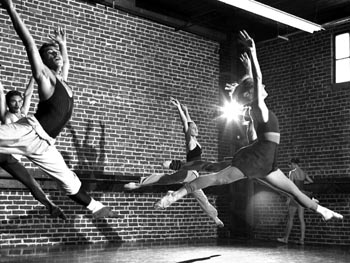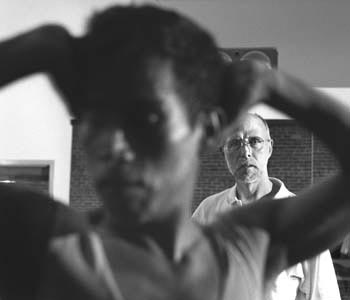Latin Connection
Rising Tide: A weightless moment during rehearsal for this weekend's 'Americas Series.'
Gary Palmer and the San Jose Dance Theatre collaborate with Peruvian and Chilean dancers on 'Americas Series'
By Traci Hukill
IN THE INFERNAL summer heat of a San Jose rehearsal studio, eight dancers swirl on cue into a ring that contracts and expands to the surge of sensual, atmospheric music. Out of the center, a female dancer rises cleanly, borne up by eight pairs of supporting arms, like a stamen from a hypnotically charged anemone.
Then she bends backward, floats out of the circle on the upraised arms of three men and droops gently to the floor. The ring disbands, and the floor fills with dancers spinning and sweeping across the room with athletic incisiveness, reconfiguring into smaller groups and breaking apart again. As they move, they gaze impassively at their reflections in the mirror along the studio wall.
For all their gorgeous composure, the dancers hesitate slightly at points, glancing at their choreographer and each other. Gary Palmer sits calmly in a director's chair, giving almost imperceptible directions with a nod of his head here, a vague gesture there. He doesn't seem concerned that the piece, Natural Selection, isn't quite finished yet, although it will premiere in a week (July 16-19 in San Jose). These dancers are seasoned professionals, accustomed to learning and polishing pieces quickly. Choreography for Palmer's other piece, Una Venganza, hasn't even begun.
Tight rehearsal schedules are to be expected in "The Americas Series"--Palmer's ongoing showcase for North and Latin American dance and ballet--due to visa restrictions and home-company obligations. Five of these dancers have come from the National Ballet of Chile--and two from the National Ballet of Peru--to join the San Jose Dance Theatre's Amanda Goldman for the performances. Returning this year are Never Navarro and Enrique Olaechea, two of the nine Peruvians who danced with Goldman and other Palmer dancers in Blue Lizard Highway last April.
Last year's performance was the first of the three-part series, and it showcased the Peruvians' strong balletic bent, just as this year highlights the European Expressionist influences on the Chileans. Next year, Palmer hopes to collaborate with Argentinian contemporary dancers.
For now, Palmer's attention rests on Goldman and Chilean César Sepúlveda as the music turns spare, and the two engage in a restrained, intertwining duet. Carola Alvear, Rayen Soto and Alfredo Bravo join them downstage as Vivian Romo, at 20 the youngest of the performers, dances with Olaechea in a far corner. The theme of tension and release returns, with the women soaring over the men and the group's composition shifting continually.
"Natural Selection has to do with changes and also with juxtapositions," Palmer tells me later. "There's a lot of open, balletic movement, then I superimpose this very tight, somewhat distressed movement on top of that, to see the resolution of where that goes."
The tall, angular Palmer moved to San Jose in 1991 from San Francisco, where he danced with San Francisco Opera Ballet and worked with contemporary innovator Lucas Hoving's performance group. Hoving, he says, danced with the master of German Expressionism Kurt Jooss, who pioneered the dramatic, contorted style of movement that punctuates Natural Selection's sweeping, breathy kinetic landscape.
It was Ernst and Lolabotka Uthoff, themselves students of Jooss, who moved to Santiago in the '40s and founded the El Ballet Nacional Chileno in 1945. "So you see," Palmer smiles, "our roots are really intertwining now."
Watchful Eye: Choreographer Gary Palmer supervises a dancer's gestures.
PALMER'S CHOREOGRAPHY plays to each dancer's strength and personality. Soto's chilly elegance, Olaechea's easy grace and Goldman's reliable accuracy meet with the variously princely and playful bearing of the other dancers to answer Palmer's vision for his work. It all comes under consideration when he chooses his performers.
Of the Chileans, Palmer says, "I was in Santiago in March watching class and rehearsal for a week. I knew the pieces I was going to do, and these dancers were the ones, I just knew. There's a similarity between the way they move and the way I move--and each one is different. That's very exciting to me."
Choreography, he explains, "is a stream-of-consciousness thing for me. I work right then and there. My work is dependent on who's there. I'm pulling my movement out of them--I don't want to superimpose movement on them."
As did Blue Lizard Highway, the new pieces Natural Selection and Una Venganza (based on the short story "Revenge" by Peruvian-born Chilean Isabel Allende) draw theatrical strength from live music and carefully constructed sets. San Francisco-based composer Marc Ream has worked with Palmer for six years. He says the 40-minute Natural Selection, consisting of 10 short pieces, has taken him all over the musical map.
"I wanted to explore lots of different types of pop music," Ream says. "There's some swing beat music, some contemporary jungle drum 'n' bass, and some more straightforward '60s pop stuff. I wanted also to juxtapose them, so sometimes there's a rather jarring switch from one to another. That kind of switch sort of drives the piece."
For both pieces Ream enlisted a harpist, percussionist, guitarist and three singers. Tenor Aurelio Viscarra, who's blessed with a big, operatic voice, adds a touch of irony to Natural Selection's pop backdrop. But in the darker world of Una Venganza, a tale of rape, love and vengeance, his role looms large as the male presence in the story while soprano Katy Stephan and contralto Susan Volkan together evoke heroine Dulce Rosa Orellano.
SET DESIGNER Jeff Wilk has worked with Palmer and Ream on a number of projects. For him, the goal is to use video technology as a scenic element, coaxing a supporting role out of a visually arresting medium that likes to assume centerstage.
Working with computer animator Larry Springer, Wilk has designed a minimalist set consisting of video screens placed carefully around the stage. Each projects a computer-generated object undergoing repetitive motion--for example, a heart-shaped object that expands and contracts, shattering and reconfiguring as it goes, over and over.
"The intention being, just like in kinetic sculpture, that you no longer are absorbed by the fact that it's moving, and you get to integrate it into the whole piece," Wilk says. "With video, you're always facing the dilemma: When does it become more interesting than the dance itself? How do you tone that down?"
For Una Venganza, Wilk says he resisted the temptation to create a literal set for a literary piece. "That to me would really distract from it." He chose instead to use a single camera and one screen. "There's an emotional austerity to it," he explains.
In addition to Palmer's pieces, the Chilean contingent will perform a piece from its repertoire, Mozartissimo, a contemporary work by Romanian choreographer Gheorghe Caciuleanu set to a medley of the Austrian composer's music. Mozartissimo incorporates strong balletic elements, for which Palmer has a great appreciation.
Last July, his dance company merged with the San Jose Dance Theatre to form an academy of 150 classical ballet students with a professional company to which youngsters can aspire.
"Every dancer needs classical ballet," he says. "You have to have the discipline before you can have freedom."
[ San Jose | Metroactive Central | Archives ]
Copyright © Metro Publishing Inc. Maintained by Boulevards New Media.
![]()

Christopher Gardner
Christopher Gardner
Members of El Ballet Nacional Chileno, El Ballet Nacional del Perú and the San Jose Dance Theatre will perform July 16-18 at 8pm and July 19 at 2pm at the San José Repertory Theater, 101 Paseo San Antonio, San Jose. Tickets are $20-$44 (408/293-5665).
From the July 16-22, 1998 issue of Metro.
![[Metroactive Stage]](http://metroactive.com/stage/gifs/stage468.gif)